
Sonic the Hedgehog 4: Episode II
System – Xbox Live, Playstation Network, iOS
Windows Phone (coming soon), Google Play, Steam
Genre – 2D platformer
Players – 1-2 online or offline co-op
Publisher – Sega/Dimps
Price – £5-10
Reviewer – Stuart “Nam” Clack
Hume Note ~ This review was played on the Xbox 360 version
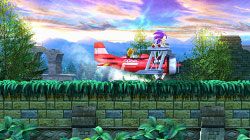 Sonic 3 & Knuckles is seen as the holy grail in Sonic fandom. It’s by a wide margin considered the best Sonic game ever made, with near faultless playability, music, graphics (both for its day, and even now they stand the test of time), storytelling and execution. It was a tough act to follow. So it got left, for over 15 years. Then Sega, realising that they have fans who would love some nostalgia, decided to make a direct sequel. Hence we got the episodic Sonic the Hedgehog 4: Episode I. Now we have its direct continuation, Sonic The Hedgehog 4: Episode II
Sonic 3 & Knuckles is seen as the holy grail in Sonic fandom. It’s by a wide margin considered the best Sonic game ever made, with near faultless playability, music, graphics (both for its day, and even now they stand the test of time), storytelling and execution. It was a tough act to follow. So it got left, for over 15 years. Then Sega, realising that they have fans who would love some nostalgia, decided to make a direct sequel. Hence we got the episodic Sonic the Hedgehog 4: Episode I. Now we have its direct continuation, Sonic The Hedgehog 4: Episode II
Almost immediately, there are two things wrong with that title. Firstly, it’s quite clearly not episodic. There is zero connection between Episode I and Episode II, the Chaos Emeralds you collect in I has no bearing in II, the 99 plus lives you grinded in Casino Street Act 2 don’t carry over, you can’t even play directly from the last act of Episode I into the start of Episode II, having instead to quit the game, and boot up the other one.
The other thing wrong with this is the fundamental one. This is not Sonic the Hedgehog 4. It does not play like any of the previous Sonic the Hedgehog games. Yes, there are moments where, if you’re watching someone else play, it looks a bit like one, but it isn’t. What it is is Sonic Advance 4. Which is unsurprising, as it’s made by Dimps, the same people who made the Sonic Advance series, and had this been called Sonic Advance 4, it might’ve attracted a lot less detractors for it.
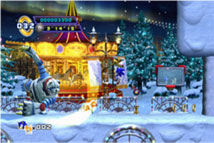 But let’s not get too into slagging it off just for its name. What matters isn’t what it’s called, but rather what it’s like, and after the generally unpopular Episode I, it’s safe to say not a lot has changed. The physics are still flawed. They’re not completely broken, and the game is playable, but again it doesn’t play like the Mega Drive games. You still lose momentum when you stop holding a direction, running is still better than rolling around, you’ll still get the same height off a spring on the first jump as you do on your fifth consecutive one, and there’s a really weird physics glitch underwater where hitting anything will make you bounce much higher as if you hit the top of it.
But let’s not get too into slagging it off just for its name. What matters isn’t what it’s called, but rather what it’s like, and after the generally unpopular Episode I, it’s safe to say not a lot has changed. The physics are still flawed. They’re not completely broken, and the game is playable, but again it doesn’t play like the Mega Drive games. You still lose momentum when you stop holding a direction, running is still better than rolling around, you’ll still get the same height off a spring on the first jump as you do on your fifth consecutive one, and there’s a really weird physics glitch underwater where hitting anything will make you bounce much higher as if you hit the top of it.
The big difference is that in this one it’s Sonic & Tails together, not Sonic alone. Which means you can fly about the place, and perform a combo roll together. Neither of these tricks are optional either. They both make up key parts of getting through levels, not in an early tutorial sense, actual final bosses are really only beatable if you exploit them. And the flying in particular has been given some truly difficult spots, where it’s essential to have mastered the skill, or you will lose a lot of lives.
In fact the whole game is genuinely rather difficult. Not impossible, and certainly not something that will infuriate too much, but in terms of difficulty it at least follows on from Episode I, managing to make the harder parts of that game look like a cakewalk by comparison. But not all of this difficulty is justified, there are a few really unfair moments where being psychic is the only way to get through without dying. In particular, the second boss has a nasty attack near the end where if you don’t know he’s going to destroy the floor, you will fall for it.
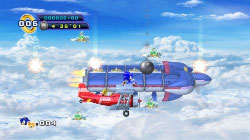 Most of the bosses in this game are serviceable, and there are no bosses here that aren’t original (though they do, at one point homage, the Metal Sonic race from Sonic CD). While some enemies are still recycled, with Bubbles still existing only as a homing attack bridge, there are some new ones, and combined with some original levels it makes the game feel less like a retread of the classic Mega Drive games. That’s not to say it’s completely perfect about that, Oil Desert for example pretty much is just Oil Ocean with different enemies, and some of the sand traps from Sandopolis, but it works well enough to stand on its own.
Most of the bosses in this game are serviceable, and there are no bosses here that aren’t original (though they do, at one point homage, the Metal Sonic race from Sonic CD). While some enemies are still recycled, with Bubbles still existing only as a homing attack bridge, there are some new ones, and combined with some original levels it makes the game feel less like a retread of the classic Mega Drive games. That’s not to say it’s completely perfect about that, Oil Desert for example pretty much is just Oil Ocean with different enemies, and some of the sand traps from Sandopolis, but it works well enough to stand on its own.
But the levels themselves don’t play the same as the Mega Drive trilogy. It’s still a few bits of multi-routing all leading up to one really hard part right before the end sign post. This was a flaw in Episode I’s level design too. There would be some good, multi-routed levels, but the bits that were infuriating would always be at the end, always unavoidable. It’s turned up all the way here, with some really hard moments at the end of acts including one brutal bit in the last zone where you’re jumping on the back of Turtaloids and the homing attack just stops working because it’s a scrolling level.
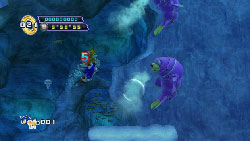 There are also some horrendous level design choices. For instance, there’s a section underwater in White Park Zone act 3 where you have to fly with tails through a cavern full of water populated by the sea lion Badnik’s that turn to giant ice balls. Said balls are indestructible, and they’re laid out in such a way that if you don’t go fast enough you’ll be trapped between them. It’s frustrating, and punishes you for not being psychic enough to know that it’d happen, and even when you know it will, it still punishes you for not being fast enough.
There are also some horrendous level design choices. For instance, there’s a section underwater in White Park Zone act 3 where you have to fly with tails through a cavern full of water populated by the sea lion Badnik’s that turn to giant ice balls. Said balls are indestructible, and they’re laid out in such a way that if you don’t go fast enough you’ll be trapped between them. It’s frustrating, and punishes you for not being psychic enough to know that it’d happen, and even when you know it will, it still punishes you for not being fast enough.
Really, this is this game’s biggest flaw. These sort of things are a staple of Dimps’ level design, and many of these stages are about as bland and forgettable as the Advance series’. They’re perfectly functional levels, but by no means memorable beyond being “the one that rips off Ice Cap Zone”, and really the whole thing looks like a development team who looked at the Mega Drive games, but never really grasped what made them good to play.
Further influences from the Advance and Rush series can be found all over the game. The running top down view was taken from there, not to mention the idea of a room full of Badniks that need to be destroyed. There’s also one enemy type in the game, the giant bear, who for some reason requires several attacks to destroy. He’s alone in that regard, and seems somewhat out of place, like he was supposed to be a mini-boss that got cancelled.
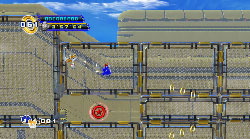 Looking at the game, it’s like there was no communication between different levels. Someone split Dimps up, told each group to make a level, and then just pasted them together. Nowhere is this more obvious than in White Park Zone, where acts 1 and 3 are slow paced, methodical snow levels, with water, avalanches, snowboarding, and the aforementioned bears. Act 2 has none of that, and is all entirely on a wooden rollercoaster, which you don’t see any of in act 3, but is the feature of the boss. It’s schizophrenic, and as if each act is trying to carve its own identity to make up for the lack of zones.
Looking at the game, it’s like there was no communication between different levels. Someone split Dimps up, told each group to make a level, and then just pasted them together. Nowhere is this more obvious than in White Park Zone, where acts 1 and 3 are slow paced, methodical snow levels, with water, avalanches, snowboarding, and the aforementioned bears. Act 2 has none of that, and is all entirely on a wooden rollercoaster, which you don’t see any of in act 3, but is the feature of the boss. It’s schizophrenic, and as if each act is trying to carve its own identity to make up for the lack of zones.
This game is at its best when it lets you be Sonic, dashing through the levels, overcoming obstacles. And act 2 of White Park Zone is excellent for that. But there are other levels where the game is almost embarrassed to be an old school video game, and it insists on trying to do really complex things at you. If you’re not snowboarding, you’re flying into and against wind, or you’re on the biplane. The game just won’t let you just play through a zone for long enough as Sonic & Tails. You always have to stop and deal with some other annoying gimmick that will take you away from the gameplay you actually want.
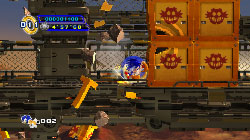 This was the one area Episode I mostly got right (bar perhaps the darkness level in Lost Labyrinth), the whole game was about Sonic, and very few levels were anything other than Sonic dashing through the levels, trying to get through the obstacles. Oh sure, there were some tedious parts, such as the never ending chase levels, and the autopilot card running, but otherwise at no point were you not just running and jumping through the obstacles.
This was the one area Episode I mostly got right (bar perhaps the darkness level in Lost Labyrinth), the whole game was about Sonic, and very few levels were anything other than Sonic dashing through the levels, trying to get through the obstacles. Oh sure, there were some tedious parts, such as the never ending chase levels, and the autopilot card running, but otherwise at no point were you not just running and jumping through the obstacles.
Episode II’s design philosophy seems to have been “the player will get bored of standard levels; they need gimmicks to be entertained.” It’s a philosophy that can be seen in the Rush series, and one Dimps has done more and more, the more they get tech that can handle it. Pretty much every level has some gimmick in it and while not all of them are awful, not all of them are appreciated.
Here’s the real kicker. Without these gimmicks, the game is a fun and enjoyable romp through some levels with moments of genuine creativity and fun about them. But then you have to deal with these gimmicks, and it stops being fun. If Generations proved anything it’s that a good Sonic game should be gimmick free and focus on speed, momentum, and platforming using those two aspects.
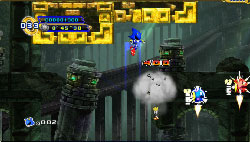 And this shines through in Episode Metal, one of the most enjoyable parts of the game. Episode Metal gets an act from each of the zones in Episode I, all unique in layout, but utilizing the physics of Episode II, and tell how Metal came back from his defeat in Sonic CD. This four level bonus contains more cutscenes than the entirety of Episode II, has much more focus on actual platforming than silly gimmicks, and as wrong as Sonic’s physics seem for Sonic himself, it actually seems to work well on Metal.
And this shines through in Episode Metal, one of the most enjoyable parts of the game. Episode Metal gets an act from each of the zones in Episode I, all unique in layout, but utilizing the physics of Episode II, and tell how Metal came back from his defeat in Sonic CD. This four level bonus contains more cutscenes than the entirety of Episode II, has much more focus on actual platforming than silly gimmicks, and as wrong as Sonic’s physics seem for Sonic himself, it actually seems to work well on Metal.
But that is too short. Just as Episode Metal really gets going, it’s over. There’s no big finish, no final boss, or any bosses for Metal, just four acts. Yes, I understand that it’s set up, and the actual battles have to canonically follow into Sonic & Tails’ story in Episode II, but why not include a non-canon end fight? Even if it ended with Metal shooting down the Tornado, would’ve been a lot more satisfying than just running through Splash Hill Zone and getting the ending you do get.
Few other things that probably should be mentioned. Firstly the music: It’s not going to be popular, as it’s a very forced synthesiser and drum machine combo that doesn’t seem so much a retro call back, rather a deliberate handicapping of the musicians. It’s got some good music, but nothing especially excellent, and certainly not up to the level Sonic fans have had over the years, but far from the awfulness people are calling it. It’s not quite as polarizing as Sonic R, and is nowhere near as catchy as the previous games music, but give it a chance and it might grow to be liked.
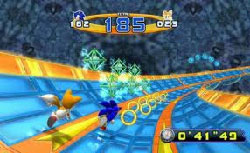 Secondly, the special stages are a pain. It’s a rehash of Sonic 2’s stages, but with a boost function added, and a few bizarre moments. The ring count to collect is extremely high, and getting any rings on the edges of the pipes is a lot harder than in Sonic 2, as Sonic is actually stiffer in these pipes than the Sonic 2 ones.
Secondly, the special stages are a pain. It’s a rehash of Sonic 2’s stages, but with a boost function added, and a few bizarre moments. The ring count to collect is extremely high, and getting any rings on the edges of the pipes is a lot harder than in Sonic 2, as Sonic is actually stiffer in these pipes than the Sonic 2 ones.
Thirdly, kudos to the animators. Some of the animations in this game, especially the overdramatic flare of Robotnik during the Metal Sonic cutscenes, and the special stage failure animations do a create job of conveying characterisation. It’s still a shame that the story isn’t complex enough to really justify it, and there are some general animation failures to do with the act of skidding to a stop and turning.
So, as a whole, Episode II is okay. It’s not brilliant, and won’t really win over anyone who hated Episode I. It might however win over some of the people who were on the fence. Yes, £10 might be a bit steep for it, especially if you didn’t buy Episode I, but the whole thing, for £20 actually doesn’t seem as bad. 28 acts across eight zones, plus 11 boss acts and 14 special stages. Look to get it on PS3 or Steam and it might be even cheaper.
 In his review of Episode I, reviewer Iain “Retro” Stewart, back in issue 253, asked “Is this fit to be called “Sonic 4?” and concluded his review saying “Whether Sega goes up or down from here will decide whether this game truly is “Sonic 4” of our childhood dreams or not, but for now....I'd not like to put an outright answer to that question.” The answer to that question now is a resounding “no”.
In his review of Episode I, reviewer Iain “Retro” Stewart, back in issue 253, asked “Is this fit to be called “Sonic 4?” and concluded his review saying “Whether Sega goes up or down from here will decide whether this game truly is “Sonic 4” of our childhood dreams or not, but for now....I'd not like to put an outright answer to that question.” The answer to that question now is a resounding “no”.
I would say the game is worse than Colours, and is even worse when you remember that Episode II came out after Generations, and it’s surprisingly faithful Classic Sonic gameplay. If I had to assign a score it would be in the mid sixties range for the overall game, with Episode Metal in and of itself scoring around the mid seventies, but the entirety of Sonic 4 scoring around the same as just Episode II on its own. In other words, the game is slightly more enjoyable if you bought Episode I beforehand, but only because Episode Metal is just that enjoyable.
 Ultimately, the single biggest gripe people may have with the game is its name. By being Sonic the Hedgehog 4, it invites itself directly to be compared to Sonic 3 & Knuckles. But as a sequel to Sonic 4 Episode I, Episode II delivers well enough, if not anything spectacular. If this game had come out six months after its first Episode, before Generations, and if Dimps had done the sensible thing and named it either Sonic Advance 4, or something new, this could’ve been received a lot better than it has.
Ultimately, the single biggest gripe people may have with the game is its name. By being Sonic the Hedgehog 4, it invites itself directly to be compared to Sonic 3 & Knuckles. But as a sequel to Sonic 4 Episode I, Episode II delivers well enough, if not anything spectacular. If this game had come out six months after its first Episode, before Generations, and if Dimps had done the sensible thing and named it either Sonic Advance 4, or something new, this could’ve been received a lot better than it has.
It is still a good, playable game, just not the great game you imagined when you first heard the name Sonic the Hedgehog 4.
 Raves:
Raves:
Physics have been improved
Some acts are great fun
Episode Metal
 Graves:
Graves:
Still not got the physics spot on
Frustrating level design
Terrible "retro" music